
Piazza Giuseppe Mazzini is a city square in the historic center of Catania, region of Sicily, Italy; it is remarkable for being ringed by 32 columns, putatively derived from an Ancient Roman basilica, arrayed in four nearly symmetrical arcades.

Piazza Giuseppe Mazzini is a city square in the historic center of Catania, region of Sicily, Italy; it is remarkable for being ringed by 32 columns, putatively derived from an Ancient Roman basilica, arrayed in four nearly symmetrical arcades.
Prior to the devastating 1693 earthquake, this was known as ‘’Piano di San Filippo’’. During the urban reconstruction that followed the earthquake, it was planned to mark this space as a marketplace, and surround the space with four symmetric arcades utilizing ancient doric columns that had been found at the site of the church of Sant’Agostino. The arcades consist of double columns at the ends with five internal arches created by four internal single column posts. The columns stand on a short black stone plinth and are surmounted by balconies with marble balustrades. The arcades are interrupted by two intersecting cross streets: via Giuseppe Garibaldi and via della Lettera. Behind the arcades are four distinct palaces: Palazzo Scammacca della Bruca to the north-east, Palazzo Asmundo di Gisira to the south-east, Palazzo Peratoner to the south-west, and Palazzo Gagliani to the north-west. The plan was to have the palaces all retain the same harmonious façade, but since the 18th-century, three of the palaces added balcony windows to the third or attic floor. The marketplaces in Catania are present elsewhere, and the ground floor arcades mainly house stores and business establishments.
An 1864 guidebook calls this the Piazza San Fillipo, and recalls the piazza, during the era of Spanish rule, could be converted into a bullfighting rink. [1]

Sicilian Baroque is the distinctive form of Baroque architecture which evolved on the island of Sicily, off the southern coast of Italy, in the 17th and 18th centuries, when it was part of the Spanish Empire. The style is recognisable not only by its typical Baroque curves and flourishes, but also by distinctive grinning masks and putti and a particular flamboyance that has given Sicily a unique architectural identity.
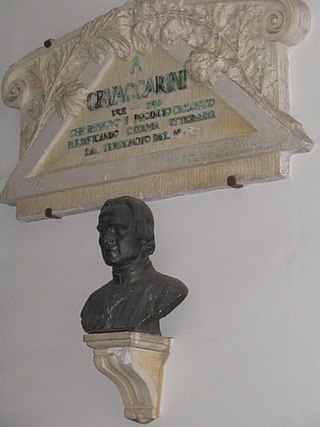
Giovanni Battista Vaccarini was a Sicilian architect, notable for his work in the Sicilian Baroque style in his homeland during the period of massive rebuilding following the earthquake of 1693. Many of his principal works can be found in the area in and around Catania.

Piazza della Repubblica is a city square in Florence, Italy. It was originally the site of the city's forum; then of its old ghetto, which was swept away during the improvement works, or Risanamento, initiated during the brief period when Florence was the capital of a reunited Italy—work that also created the city's avenues and boulevards. At that time, the Loggia del Pesce from the Mercato Vecchio was also moved to Piazza Ciompi. The square's Giubbe Rosse cafe has long been a meeting place for famous artists and writers, notably those of Futurism.

Palazzo degli Elefanti is a historical building in Catania, region of Sicily, southern Italy. It currently houses the city's Town Hall. In the past, the prior building was also known as the Palazzo Senatorio or Loggia Senatoria.

The Palazzo Biscari is a monumental private palace located on Via Museo Biscari in Catania, Sicily, southern Italy. The highly decorative interiors are open for guided tours, and used for social and cultural events.

The Palazzo Tezzano is a monumental palace in Piazza Stesicoro, in the center of Catania, Sicily, southern Italy. The via Etnea, with prominent shops, bisects the Piazza; this palazzo rises at the northwest intersection with this via, across from the white stone, neoclassical Palazzo Paterno del Toscano.

Neoclassical architecture in Milan encompasses the main artistic movement from about 1750 to 1850 in this northern Italian city. From the final years of the reign of Maria Theresa of Austria, through the Napoleonic Kingdom of Italy and the European Restoration, Milan was in the forefront of a strong cultural and economic renaissance in which Neoclassicism was the dominant style, creating in Milan some of the most influential works in this style in Italy and across Europe. Notable developments include construction of the Teatro alla Scala, the restyled Royal Palace, and the Brera institutions including the Academy of Fine Arts, the Braidense Library and the Brera Astronomical Observatory. Neoclassicism also led to the development of monumental city gates, new squares and boulevards, as well as public gardens and private mansions. Latterly, two churches, San Tomaso in Terramara and San Carlo al Corso, were completed in Neoclassical style before the period came to an end in the late 1830s.

Piazza d'Aracoeli is a square of Rome (Italy), placed at the base of the Capitoline Hill, in the Rione X Campitelli.
Piazza del Duomo is the main city square in Catania, Italy, flanked by both the centers of civic and religious power.
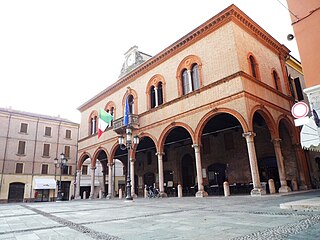
The Mirandola Town Hall is a historic public building located in the city center of Mirandola, in the province of Modena, Italy.

San Placido is a Roman Catholic church and former-Benedictine monastery located on the piazza of the same name in Catania, Sicily, southern Italy. The complex, two blocks east of the Catania Cathedral, spans a polygonal block encompassed by the Via Vittorio Emanuele II on the north, the via Landolina to the east, the via Museo Biscari on a south diagonal, and to the west the piazza San Placido and Via Porticello. Part of the convent is occupied by the Palazzo della Cultura, used for cultural activities and exhibitions. The Monastero di San Placido also serves presently as the Archivio di Stato di Catania.

Santa Agata al Carcere, sometimes called Santo Carcere or the Carcere church is a Roman Catholic church located on Piazza Santo Carcere #7, in the city of Catania, Sicily, southern Italy. It is one of three nearly adjacent churches dedicated in honor of St Agatha of Sicily in this neighborhood, the other two being Sant'Agata alla Fornace and Sant'Agata la Vetere.
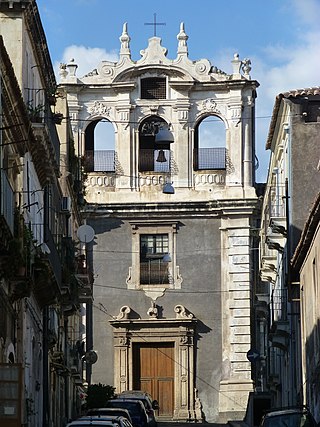
The Conservatorio delle Verginelle di Sant'Agata is a former orphanage-hostel and church located on via Teatro Greco #82, with the northern facade paralleling Piazza Dante and the Monastery of San Nicolo l'Arena in the center of the city of Catania, region of Sicily, Italy. Presently it houses the facilities of the Faculty of the Scienza della Formazione of the University of Catania, educating future science teachers.

The Palazzo Gravina-Cruyllas is a palace located on the corner of Piazza San Francesco and Via Vittorio Emanuele, in the center of the city of Catania, Sicily, southern Italy. Vincenzo Bellini was born here, and the site now houses a museum dedicated to the opera composer: the Museo Civico Belliniano. The entrance stands across the piazza from the Monument to Blessed Giuseppe Dusmet and the church of San Francesco d'Assisi all'Immacolata.

The Palazzo dell'Università or Palazzo Centrale dell'Università di Catania is a monumental palace located in Piazza Universitaria, in the center of the city of Catania, region of Sicily, southern Italy. Since its construction, it has housed the main offices of the University of Catania, and stands across the piazza from the Palazzo San Giuliano, also housing offices of the university. It presently houses the offices of the rector, university offices, the "Giambattista Caruso" Regional Library, and a small museum of geology and archeology.
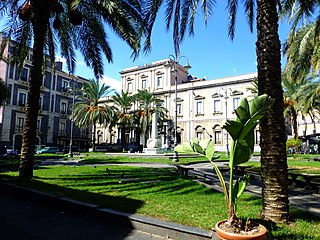
The Palazzo Cutelli is a historic palace, once housing the Collegio Cutelli, now the semiprivate Convitto Cutelli, a boarding school from primary to lyceum grades, located on Via Vittorio Emanuele #56 in central Catania, region of Sicily, Italy.
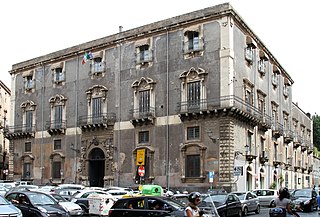
The Palazzo Manganelli is a Baroque monumental palace located in Piazza Manganelli, in the center of the city of Catania, region of Sicily, southern Italy. It is still lived in by heirs of the family, and also houses a hotel. The busy piazza serves mainly as a parking lot; at the north is a civic art gallery, housed in the former church of San Michele Minore. To the south, across Via Antonino di Sangiuliano stands the Teatro Sangiorgi. At one time, a building here housed the Istituto per la Educazione delle Fanciulle.

The Palazzo Paternò del Toscano, also known as the Palazzo del Toscano, is an notable palace in Piazza Stesicoro, in the center of Catania, region of Sicily, southern Italy. The building now houses many shops, but is also used by schools, and for cultural programs. The white stone facade stands before the Monument to Vincenzo Bellini and rises in contrast to the palace across via Aetna, the white and black Palazzo Tezzano.

The Palazzo Gioeni Asmundo is an notable palace located on via Fragalà #10 facing Piazza dell'Università in the center of Catania, region of Sicily, southern Italy. The building, like the two other prominent palaces facing this piazza, now houses offices of the University of Catania.

The Palazzo del Seminario dei Chierici, also known as the Palazzo dei Chierici is a monumental building located facing the piazza Duomo in Catania, region of Sicily, Italy. It stands aside from the Cathedral of Sant'Agata, and across the piazza from the Palazzo degli Elefanti, which houses city hall. Between these two palaces, the Monument of the Elephant with obelisk is located.
37°30′06″N15°05′06″E / 37.5018°N 15.0849°E